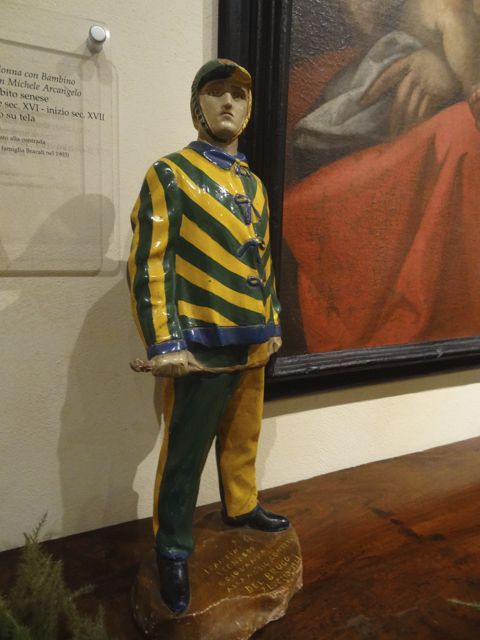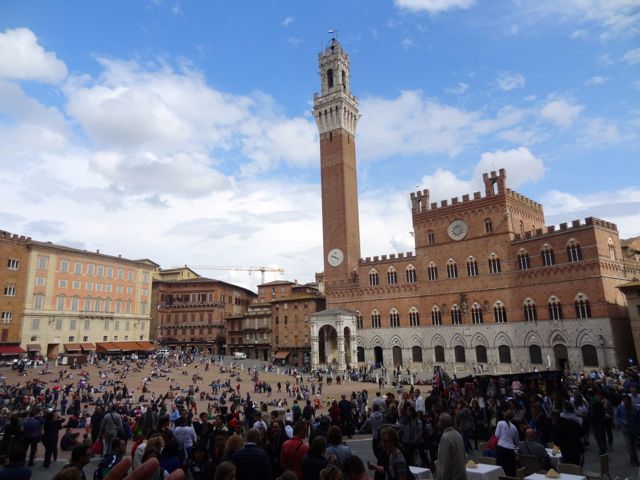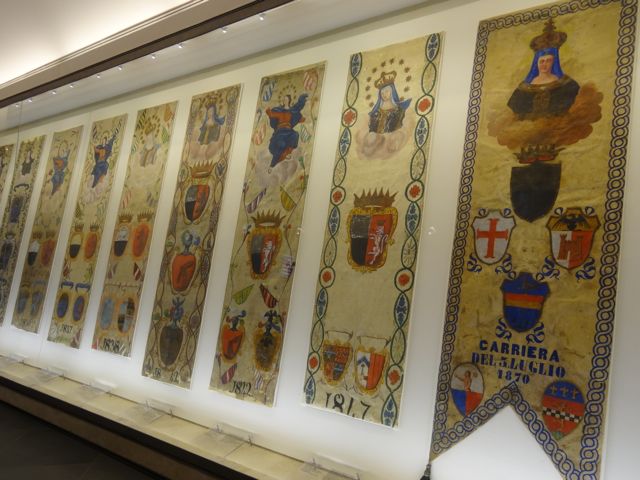Siena, Italy is known for its landmark, Piazza del Campo, a famous town square and a UNESCO world heritage site. I take a behind-the-scenes tour of Bruco Contrada, or the Caterpillar District, which is one of the 17 Siena wards that takes part in the Palio (race).
Up until now, I am unfamiliar with the contrada culture and how dynamic it is. A contrada is basically like a district, often made up of nothing but a few streets. Established in the Middle Ages for military reasons, now the contrade are simply areas of localised patriotism, celebrations of every important event including baptisms, deaths, marriages, church holidays, victories at the Palio, even wine or food festivals.
One has to be born in a contrada to be a member of it. Someone who buys a house, gets married or moves, does not get a membership into the contrada. This can be confusing because, say if you were born in the caterpillar contrada, your wife was born in the giraffe contrada, and your child is born in dragon contrada, then all three of you have membership to different communities. The members of the contrade meet weekly, so each person has to celebrate important events (like deaths, births, etc) only within one’s own contrada.
Each contrada is named after an animal or symbol and has a long history, and complicated set of heraldic and semi-mythological associations. We enter the home of caterpillar contrada, which looks like another home from the outside. A newly renovated establishment with modern decor, looks nothing like ancient culture to me. However, there is a chapel, museum, garden, kitchen and hall.
Bruco (Caterpillar)
 Bruco is situated to the north of the Piazza del Campo. Traditionally, its residents worked in the silk trade.
Bruco’s symbol is a crowned caterpillar crawling on a rose. Its colours are green and yellow, trimmed with blue.
Bruco is one of only four nobile (noble) contrade; its title was earned in 1369 by its people’s bravery in helping to defeat Charles IV, and consolidated in 1371 when they led the revolt to replace the Sienese council with a people’s government.
Its Sede is at Via del Comune, 44.
Its patron Saint is Madonna (Visitation of the Saintest Mary) and the Titulary feast is on 2 July.
Its motto is “Come rivoluzion suona il mio nome” (As revolution sounds my name).
It is allied to the Istrice, Nicchio and Torre contrade and not officially opposed to any other contrade since its animosity with neighbouring Giraffa (giraffe) ended, formally, in 1996.
Last victory- 16 August 2008. It has 37 official victories.
Bruco is situated to the north of the Piazza del Campo. Traditionally, its residents worked in the silk trade.
Bruco’s symbol is a crowned caterpillar crawling on a rose. Its colours are green and yellow, trimmed with blue.
Bruco is one of only four nobile (noble) contrade; its title was earned in 1369 by its people’s bravery in helping to defeat Charles IV, and consolidated in 1371 when they led the revolt to replace the Sienese council with a people’s government.
Its Sede is at Via del Comune, 44.
Its patron Saint is Madonna (Visitation of the Saintest Mary) and the Titulary feast is on 2 July.
Its motto is “Come rivoluzion suona il mio nome” (As revolution sounds my name).
It is allied to the Istrice, Nicchio and Torre contrade and not officially opposed to any other contrade since its animosity with neighbouring Giraffa (giraffe) ended, formally, in 1996.
Last victory- 16 August 2008. It has 37 official victories.
One of the members, Dario, gives me a tour of the community center which houses the Bruco’s Palio trophies and costumes. He gives me a brief history of how the Palio came about and why the Italians are still so passionate about it. We touch upon every detail about the horse racing culture: horses are assigned by lottery; jockeys are hired based on their desire to win; each new costume designed is worth 5,000 euros; money is raised by the residents of the contrada; transactions are made offline; and parties are thrown all week. It is incredible to realize that there are millions of euros and years of planning that go into a 90-second race.
The Palio di Siena (known locally simply as Il Palio) is not just a horse race, it is an annual event which involves the entire community’s hearts, minds and preoccupations for years. The race is actually held twice each year, on July 2 and August 16, in Siena, located in the heart of Tuscany. The Palio held on July 2 is named Palio di Provenzano, in honour of the Madonna of Provenzano, who has a church in Siena. The Palio held on August 16 is named Palio dell’Assunta, in honour of the Assumption of Mary.
Ten horses and riders, bareback and dressed in the appropriate colours, represent ten of the seventeen contrade, or city wards. The race itself, circles the Piazza del Campo, three times and usually lasts no more than 90 seconds. Crowds cheer and emotions run high. From children to seniors, everyone in the contrada is rooting for his jockey to win.
The winner is awarded a banner of painted silk, or palio, which is hand-painted by a different artist for each race. The enthusiasm after the victory, however, is so extreme that the ceremony of attribution of the palio is quite instantaneous, being the first moment of a months-long celebration for the winning ward. There are occasional outbreaks of violence between partisans of rival contrade. More than the palio, the bragging rights against the economy contrade, calls for weeklong celebrations. The winning ward hosts a nonstop party with free wine, food, and music.




